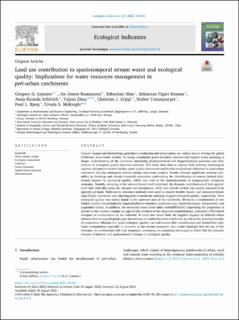| dc.contributor.author | Lemaire, Gregory G. | |
| dc.contributor.author | Rasmussen, Jes Jessen | |
| dc.contributor.author | Höss, Sebastian | |
| dc.contributor.author | Figari Kramer, Sebastian | |
| dc.contributor.author | Schittich, Anna-Ricarda | |
| dc.contributor.author | Zhou, Yujian | |
| dc.contributor.author | Köppl, Christian J. | |
| dc.contributor.author | Traunspurger, Walter | |
| dc.contributor.author | Bjerg, Poul L. | |
| dc.contributor.author | McKnight, Ursula S. | |
| dc.date.accessioned | 2023-03-10T11:36:33Z | |
| dc.date.available | 2023-03-10T11:36:33Z | |
| dc.date.created | 2022-11-07T14:43:25Z | |
| dc.date.issued | 2022 | |
| dc.identifier.citation | Ecological Indicators. 2022, 143,109360. | en_US |
| dc.identifier.issn | 1470-160X | |
| dc.identifier.uri | https://hdl.handle.net/11250/3057670 | |
| dc.description.abstract | Climate change and intensifying agricultural production and urbanization are central factors driving the global freshwater biodiversity decline. To design sustainable green transition schemes and support urban planning, a deeper understanding of the numerous interacting physicochemical and biogeochemical processes and their relation to ecological quality becomes essential. This study thus aims to explore links between hydrological regimes and patterns evident for key water quality parameters and benthic invertebrate indicators in a peri-urban catchment that has undergone several stream restoration projects. Results indicate significant seasonal variability in discharge and physico-chemical parameters confounding the identification of sources behind detrimental impacts on ecological quality, which may lead to the implementation of inappropriate mitigation strategies. Notably, sampling at the sub-catchment level underlined the dynamic contributions of both agricultural and urban-like areas for nitrogen and phosphorus, while non-volatile carbon was mainly exported from agricultural lands. Multivariate statistical methods were used to classify benthic macro- and meioinvertebrate (specifically nematode) taxa showing poor-to-moderate and poor-to-good ecological quality, respectively. Poor ecological quality was mostly found in the upstream part of the catchment, driven by a combination of low habitat quality and periodically impaired physico-chemical conditions (e.g. dissolved oxygen, temperature, and suspended solids). In addition, the nematode-based stress index NemaSPEAR[%] (expressing the proportion of species-at-risk within a sample and specifically sensitive to the chemical contamination), indicated a TSS-related transport of contaminants to the sediment. It could also reveal both the negative impacts of different urban features (low ecological quality just downstream of combined sewer overflows), as well as the potential benefits of wastewater effluents (i.e. good ecological quality, via well-treated flow contributions and limited fine sediment accumulation especially in summer) on the stream ecosystem. Our results highlight that the use of this indicator, in combination with high frequency monitoring are promising techniques to better link the dynamic impacts of land use and spatiotemporal changes in ecological quality. | en_US |
| dc.language.iso | eng | en_US |
| dc.publisher | Elsevier | en_US |
| dc.rights | Attribution-NonCommercial-NoDerivatives 4.0 Internasjonal | * |
| dc.rights.uri | http://creativecommons.org/licenses/by-nc-nd/4.0/deed.no | * |
| dc.title | Land use contribution to spatiotemporal stream water and ecological quality: Implications for water resources management in peri-urban catchments | en_US |
| dc.title.alternative | Land use contribution to spatiotemporal stream water and ecological quality: Implications for water resources management in peri-urban catchments | en_US |
| dc.type | Peer reviewed | en_US |
| dc.type | Journal article | en_US |
| dc.description.version | publishedVersion | en_US |
| dc.source.pagenumber | 12 | en_US |
| dc.source.volume | 143 | en_US |
| dc.source.journal | Ecological Indicators | en_US |
| dc.identifier.doi | 10.1016/j.ecolind.2022.109360 | |
| dc.identifier.cristin | 2070112 | |
| dc.source.articlenumber | 109360 | en_US |
| cristin.ispublished | true | |
| cristin.fulltext | original | |
| cristin.qualitycode | 1 | |

